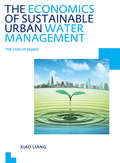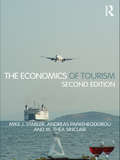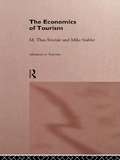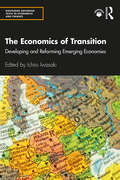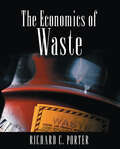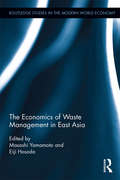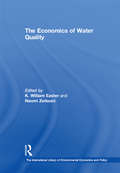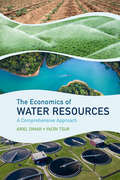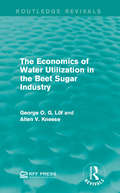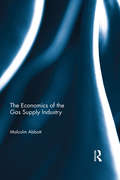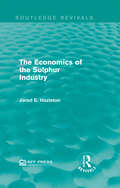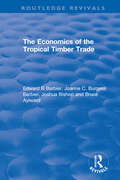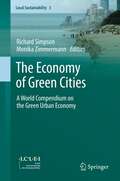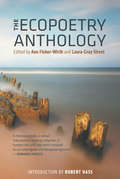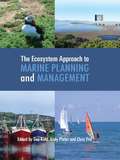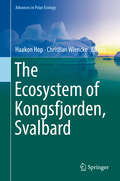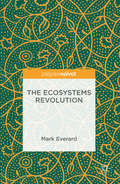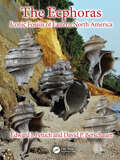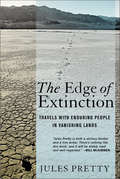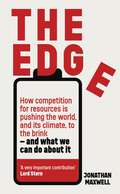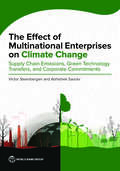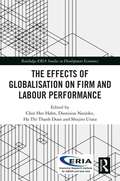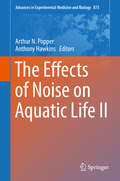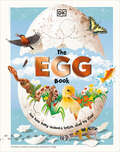- Table View
- List View
The Economics of Sustainable Urban Water Management: UNESCO-IHE PhD Thesis
by Xiao LiangRapid population growth, limited water availability, climate variability and environmental pollution together cause a significant challenge to provide sufficient water to urban residents in a sustainable and effective way. Advanced water treatment technology can contribute to the solution of problems physically, but it may not ensure sustainable op
The Economics of Tourism
by Mike J. Stabler Andreas Papatheodorou M. Thea SinclairThis new edition of The Economics of Tourism reflects the tremendous changes that have occurred in the tourism sector in the last twelve years. It recognizes that the nature of tourism demand and supply is being transformed by innovations in information communication technologies, market liberalization and climate change. Paralleling this, there is much greater interest in the study of tourism by both students and researchers in mainstream economics. The text is now in four parts covering: demand; supply; national, regional and international matters and environmental issues. The concluding chapter appraises the state of the economic research into tourism. The increased interest in tourism has engendered the development of new methods of analysis and the refinement of established ones. Accordingly, the book has been extensively restructured, revised and expanded with two new chapters: chapter six of the first edition is now broken down into two and a new chapter has been added on environmental issues to take account of new developments, critically review the associated literature and consider future trends in tourism economics research. The reader-friendliness of the book has also been enhanced in various ways, such as the extensive chapter cross-referencing to refresh the reader’s memory and the inclusion of a detailed list of abbreviations. The Economics of Tourism will continue to make accessible for the non-specialist, the application and relevance of economics to tourism. Extensively revised and updated, including research and case studies the textbook will be an indispensable resource for both students and researchers.
The Economics of Tourism (Routledge Advances In Tourism Ser.)
by M. Thea Sinclair Mike StablerMakes a key contribution from an economic standpoint to the understanding of tourism. Examining such issues as how tourism firms operate in national and global contexts, the effects of tourism on destination areas, the demand for tourism, and the interaction between tourism and natural environments, this comprehensive introduction explains how econ
The Economics of Transition: Developing and Reforming Emerging Economies (Routledge Advanced Texts in Economics and Finance)
by Ichiro IwasakiIn the last three decades since the fall of the Berlin Wall, there has been a vast amount of study looking at transforming the planned economy to a market economy from both theoretical and empirical aspects. This book provides an overview and insight into transition economies in the recent decades and looks at key economics topics from the so-called “transition strategy debate” to environmental reform. The book also includes an analytical review and meta-analysis of the existing literature. By integrating theoretical discussions and synthesizing empirical findings in a systematic manner, this book may help to enlighten the debate on the timing, speed, and policy sequence of economic transition. The book will particularly appeal to researchers, policy makers, other practitioners, and under- and post-graduate students who are interested in transition economies in Eastern Europe, the former Soviet Union, Southeast Asia, and China. It aims to be read as an advanced reader.
The Economics of Waste (Rff Press Ser.)
by Richard C. PorterIn this concise, engaging, and provocative work, Richard Porter introduces readers to the economic tools that can be applied to problems involved in handling a diverse range of waste products from business and households. Emphasizing the impossibility of achieving a zero-risk environment, Porter focuses on the choices that apply in real world decisions about waste. Acknowledging that effective waste policy integrates knowledge from several disciplines, Porter focuses on the use of economic analysis to reveal the costs of different policies and therefore how much can be done to meet goals to protect human health and the environment. With abundant examples, he considers subjects such as landfills, incineration, and illegal disposal. He discusses the international trade in waste, the costs and benefits of recycling, and special topics such as hazardous materials, Superfund, and nuclear waste. While making clear his belief that not every form of waste presents the same amount of risk, Porter stresses the need for open-minded approaches to developing new policies. For students, policymakers, and general readers, he provides insight and accessibility to a subject that others might leave out-of-sight, out-of-mind, or buried under an impenetrable prose of statistics and jargon.
The Economics of Waste Management in East Asia (Routledge Studies in the Modern World Economy)
by Masashi Yamamoto Eiji HosodaThe existing literature provides very little information on the real and current process of waste disposal and recycling in China. China generates large amount of waste and it covers about 20 % of the world waste trade. This book focuses on China’s waste management and recycling policy. The book also examines the relationship between China’s waste management and recycling industry and its legal structure. It fills in the gap by providing insight into topics on how to resolve China’s waste management and recycling problems, theories and empirical studies on waste and management as well as waste management policies in East Asia. It also includes comparative analysis through case studies on other Asian countries such as Thailand and Japan.
The Economics of Water Quality (The International Library of Environmental Economics and Policy)
by Naomi ZeitouniThis volume brings together a number of prominent economic studies all of which deal with key water quality issues. The studies focus on the economic aspects of water quality including identifying the polluters' actions and incentives, designing and comparing control mechanisms, analyzing the costs and benefits of water quality programmes, and finally managing transboundary water quality. They all make recommendations for improving water quality through changing incentives, programmes and/or policies.
The Economics of Water Resources: A Comprehensive Approach (Natural Resource Management And Policy Ser. #24)
by Ariel Dinar Yacov TsurPopulation growth and rising living standards, on the one hand, and changing climate, on the other hand, have exacerbated water scarcity worldwide. To address this problem, policymakers need to take a wide view of the water economy – a complex structure involving environmental, social, economic, legal, and institutional aspects. A coherent water policy must look at the water economy as a whole and apply a comprehensive approach to policy interventions. Written by two of the world's leading scholars on economics of water, this is the first graduate-level textbook on the topic. The book discusses water resource management within a comprehensive framework that integrates the different, yet highly entwined, elements of a water economy. It follows the steps needed to develop a well-designed set of policies based on detailed analyses of intervention measures, using multi-sectoral and economy-wide examples from a variety of locations and situations around the world.
The Economics of Water Utilization in the Beet Sugar Industry (Routledge Revivals)
by Allen V. Kneese George O. LöfOriginally published in 1965, this case study of the beet sugar industry undertaken by George O. G. Lof and Allen V. Kneese illustrates the economic importance of water to industry. This study delves into the history and technology of the beet sugar industry to demonstrate the economic impact of the water environment and how water waste can be reduced in other industries. This title will be of interest to students of environmental studies.
The Economics of the Gas Supply Industry
by Malcolm AbbottIn recent years, natural gas has become a major source of energy, with trade across borders increasing through both pipelines and as Liquefied Natural Gas (LNG). Owing to this global development, this book traces the development of the gas supply industry, from localised to national industries and national industries to a major global industry. It looks at the basic economics and origins of the industry, as well as the role of the government in its development and relation to international markets. The book highlights certain economic characteristics such as the industry’s vertical and horizontal structure, the composition of consumer demand and the role of government in safety, planning and investment. With the understanding of the industry's long term development, the book helps to illustrate the relationship between natural gas producers and importers of LNG. This book would be of interest to scholars majoring in resource economics and energy economics, as well as to international practitioners in the natural gas market.
The Economics of the Sulphur Industry (Routledge Revivals)
by Jared E. HazletonBetween the 1950’s and 1970’s, the Sulphur industry continued to grow despite occasional shortages and excesses. In this study originally published in 1970, Hazleton focuses on the Frasch sulphur industry to explore issues such as competing sources of sulphur, the possibilities of sulphur being obtained as a result of pollution-abating policies and the conditions under which future supplies are likely to become available. This title will be of interest to students of Environmental Studies.
The Economics of the Tropical Timber Trade (Routledge Revivals)
by Joshua Bishop Edward B Barbier Joanne C. Burgess Barbier Bruce AylwardOriginally published in 1994, The Economics of the Tropical Timber Trade provides a detailed analysis of the economic linkages between the trade and forest degradation. Based on a report prepared for the ITTO, it looks current and future market conditions at the time of publication, and assesses the impacts on current and future market conditions, and assesses the impacts on tropical forests of both the international timber trade and domestic demand. The authors examine the causes of deforestation and compare the environmental impacts of the timber trade with other factors, such as the conversion of the forests to agriculture. Finally, they assess the national and international trade policy options, and discuss the potential role of interventions in the international timber trade in promoting efficient and sustainable use of forest resources. The book will be of interest to those concerned with forest management and policy, trade and environment, and with the economics of conversation and resource use.
The Economy of Green Cities: A World Compendium on the Green Urban Economy
by Monika Zimmermann Richard SimpsonThis volume bridges the gap between the global promotion of the Green Economy and the manifestation of this new development strategy at the urban level. Green cities are an imperative solution, not only in meeting global environmental challenges but also in helping to ensure socio-economic prosperity at the local level.
The Ecopoetry Anthology
by Robert Hass Laura-Gray Street Ann Fisher-WirthDefinitive and daring, The Ecopoetry Anthology is the authoritative collection of contemporary American poetry about nature and the environment--in all its glory and challenge. From praise to lament, the work covers the range of human response to an increasingly complex and often disturbing natural world and inquires of our human place in a vastness beyond the human.To establish the antecedents of today's writing,The Ecopoetry Anthology presents a historical section that includes poetry written from roughly the mid-nineteenth to the mid-twentieth century. Iconic American poets like Walt Whitman and Emily Dickinson are followed by more modern poets like Wallace Stevens, William Carlos Williams, Ezra Pound, and even more recent foundational work by poets like Theodore Roethke, Elizabeth Bishop, Robert Hayden, and Muriel Rukeyser. With subtle discernment, the editors portray our country's rich heritage and dramatic range of writing about the natural world around us.
The Ecosystem Approach to Marine Planning and Management (Earthscan Oceans)
by Sue Kidd Andy Plater Chris FridThe marine environment is one of our most precious yet fragile natural resources. It provides a wide range of essential goods and services, including food, regulation of climate and nutrient cycling, as well as a setting for transport, recreation and tourism. This environment is however extremely complex and very sensitive to development pressures and other forms of human influence. Planning and management of the sea are similarly complicated, reflecting intricate legal, institutional and ownerships patterns. This creates a situation where marine ecosystems are vulnerable to over-exploitation or neglect. The Ecosystem Approach to Marine Planning and Management describes how growing concern about the state of our seas is resulting in the development of new approaches to marine planning and management. For example, the United Nations Environment Programme has called for the widespread introduction of Marine Spatial Planning (MSP), and the European Union has recently been consulting on a new European Maritime Policy designed to stimulate economic growth but at the same time protect the resource base. Within the United Kingdom, the 2010 Marine Act draws upon the experience of town and country planning and brings into being a new system of Marine Spatial Planning. The authors show that a common feature of all these developments is an appreciation that more integrated forms of planning and management are required for our seas and that new arrangements must draw together understanding from natural science, social science and many other perspectives. Adopting such a trans-disciplinary and holistic (or 'ecosystems') approach, the book distils the expertise of these different disciplines and seeks to promote a broader understanding of the origins and practicalities of new approaches to marine planning and management.
The Ecosystem of Kongsfjorden, Svalbard (Advances in Polar Ecology #2)
by Christian Wiencke Haakon HopThis book focuses in detail on all ecologically important aspects of the Kongsfjorden system such as the marine and atmospheric environment including long-term monitoring, Ecophysiology of individual species, structure and function of the ecosystem, ecological processes and biological communities.The contributed articles include review articles and research articles that have a wider approach and bring the current research up-to-date. This book will form a baseline for future work.
The Ecosystems Revolution
by Mark EverardThis book explores humanity's relationship with the natural world throughout evolutionary history, and the need to reorient this onto a symbiotic basis. It integrates the themes of natural and artificial selection, the characteristics of historic 'revolutions', and directed versus random change. Inspiring community-based projects, mainly from the developing world, show how ecosystem regeneration uplifts human livelihoods in a positively reinforcing cycle, embodying lessons germane to co-creating a Symbiocene era wherein humanity's substantial influence (the Anthropocene) achieves increasing symbiosis with the natural processes shaping the former Holocene epoch. The Ecosystems Revolution provides practical, positive examples, highlighting the attainability of an 'ecosystems revolution'.
The Ecotechnic Future
by John Michael Greer"[John Michael] Greer's work is nothing short of brilliant. He has the multidisciplinary smarts to deeply understand our human dilemma as we stand on the verge of the inevitable collapse of industrialism. And he wields uncommon writing skills, making his diagnosis and prescription entertaining, illuminating, and practically informative. Not to be missed."--Richard Heinberg, Senior Fellow, Post Carbon Institute and author of Peak Everything"There is a great deal of conventional wisdom about our collective ecological crisis out there in books. The enormous virtue of John Michael Greer's work is that his wisdom is never conventional, but profound and imaginative. There's no one who makes me think harder, and The Ecotechnic Future pushes Greer's vision, and our thought processes in important directions." --Sharon Astyk, farmer, blogger, and author of Depletion and Abundance and A Nation of Farmers "In The Ecotechnic Future, John Michael Greer dispels our fantasies of a tidy, controlled transition from industrial society to a post-industrial milieu. The process will be ragged and rugged and will not invariably constitute an evolutionary leap for the human species. It will, however, offer myriad opportunities to create a society that bolsters complex technology which at the same time maintains a sustainable interaction with the ecosystem. Greer brilliantly inspires us to integrate the two in our thinking and to construct local communities which concretely exemplify this comprehensive vision." --Carolyn Baker, author of Sacred Demise: Walking The Spiritual Path of Industrial Civilization's Collapse, and publisher/editor, Speaking Truth to PowerIn response to the coming impact of peak oil, John Michael Greer helps us envision the transition from an industrial society to a sustainable ecotechnic world--not returning to the past, but creating a society that supports relatively advanced technology on a sustainable resource base.Fusing human ecology and history, this book challenges assumptions held by mainstream and alternative thinkers about the evolution of human societies. Human societies, like ecosystems, evolve in complex and unpredictable ways, making it futile to try to impose rigid ideological forms on the patterns of evolutionary change. Instead, social change must explore many pathways over which we have no control. The troubling and exhilarating prospect of an open-ended future, he proposes, requires dissensus--a deliberate acceptance of radical diversity that widens the range of potential approaches to infinity.Written in three parts, the book places the present crisis of the industrial world in its historical and ecological context in part one; part two explores the toolkit for the Ecotechnic Age; and part three opens a door to the complexity of future visions.For anyone concerned about peak oil and the future of industrial society, this book provides a solid analysis of how we got to where we are and offers a practical toolkit to prepare for the future.John Michael Greer is a certified Master Conserver, organic gardener, and scholar of ecological history. He blogs at The Archdruid Report (www.thearchdruidreport.blogspot.com), and is the author ofThe Long Descent.
The Ecphoras: Iconic Fossils of Eastern North America
by Edward J. Petuch David P. BerschauerIn the Miocene and Pliocene fossil shell beds of the eastern United States, the single most spectacular molluscan species radiation is seen in the ecphora shells (the Tribe Ecphorini). These bizarrely shaped gastropods, with their distinctive ribbed shell sculpture, represent a separate branch of the Subfamily Ocenebridae, Family Muricidae. Characteristically, these muricid gastropods are heavily ornamented with spiral ribs and cords and are considered some of the most beautiful and interesting groups of fossil mollusks found along the Atlantic Coastal Plain and Floridian Peninsula. The ecphoras are greatly sought after by fossil collectors. The ecphora faunas, and their individual species and subspecies, are illustrated and described in detail, along with photographs of ecphora-bearing geological units and in-situ specimens. The authors list the 67 known species and subspecies that are recognized as valid, arranged by the eight genera and five subgenera that encompass these taxa.
The Edge of Extinction: Travels with Enduring People in Vanishing Lands
by Jules PrettyIn The Edge of Extinction, Jules Pretty explores life and change in a dozen environments and cultures across the world, taking us on a series of remarkable journeys through deserts, coasts, mountains, steppes, snowscapes, marshes, and farms to show that there are many different ways to live in cooperation with nature. From these accounts of people living close to the land and close to the edge emerge a larger story about sustainability and the future of the planet. Pretty addresses not only current threats to natural and cultural diversity but also the unsustainability of modern lifestyles typical of industrialized countries. In a very real sense, Pretty discovers, what we manage to preserve now may well save us later. Jules Pretty's travels take him among the Maori people along the coasts of the Pacific, into the mountains of China, and across petroglyph-rich deserts of Australia. He treks with nomads over the continent-wide steppes of Tuva in southern Siberia, walks and boats in the wildlife-rich inland swamps of southern Africa, and experiences the Arctic with ice fishermen in Finland. He explores the coasts and inland marshes of eastern England and Northern Ireland and accompanies Innu people across the taiga’s snowy forests and the lakes of the Labrador interior. Pretty concludes his global journey immersed in the discrete cultures and landscapes embedded within the American landscape: the small farms of the Amish, the swamps of the Cajuns in the deep South, and the deserts of California. The diverse people Pretty meets in The Edge of Extinction display deep pride in their relationships with the land and are only willing to join with the modern world on their own terms. By the examples they set, they offer valuable lessons for anyone seeking to find harmony in a world cracking under the pressures of apparently insatiable consumption patterns of the affluent.
The Edge: How competition for resources is pushing the world, and its climate, to the brink – and what we can do about it.
by Jonathan MaxwellWe live in a World which, though the origins are long, seems suddenly transformed by economic events way out of our control. In seeking stability, we must acknowledge the seismic scale of the challenge, and understand the devastating impact of global energy inefficiency. Every society, organisation, business, household and individual must put efficiency first - not just to save money and carbon and improve resilience, but to reduce the risk, or effect, of conflict.THE EDGE is a very contemporary look at how the world has been transformed by recent economic events, focusing on climate change, the war in Ukraine, the Chinese economy and the challenges the world faces around inflation, energy, transport, fuel, imports etc. Written from an economist/investor's perspective, with lessons for pretty much every institution challenged by these developments, it is a timely and essential resource authored by a global expert with peerless connections, from major organisations to government insiders, from investors to energy corporations. It will help businesses and economies currently at the mercy of the markets to transition towards sustainability, productivity and prosperity, and help everyone understand the world in 2023.
The Effect of Multinational Enterprises on Climate Change: Supply Chain Emissions, Green Technology Transfers, and Corporate Commitments (Climate Change and Development)
by Victor Steenbergen Abhishek SauravMultinational enterprises (MNEs) provide both a fundamental risk to and an opportunity for climate change mitigation. The climate ambitions of MNEs will affect the environmental performance of countries around the world. As a leading actor, proactive MNEs can impose sustainability standards or encourage green technology transfers that, in some cases, could affect millions of producers and accelerate the climate transition. However, obstructive MNEs may equally hold back any progress to reduce a country's emissions via inaction or by actively resisting, obstructing, or lobbying against change. The objective of this report is to study the effect of MNEs on climate change. Toward this goal, the report reviews the latest available data, conducts new empirical analysis, and summarizes pioneering literature. The report answers four key questions related to the relationship between MNEs and climate change: 1) What effect do MNEs currently have on climate change, both through their own activities and through the emissions of their broader supply chains?; 2) How do MNEs shape the potential transfer of green technologies to domestic firms, and how do different types of interactions with MNEs stimulate such technology transfers?; 3) How committed are leading MNEs currently to transitioning their supply chains to net-zero emissions by 2050, and do they have long-, medium-, and short-range strategies to realize this?; 4) What types of policies can influence MNEs' effects on climate change?
The Effects of Globalisation on Firm and Labour Performance (Routledge-ERIA Studies in Development Economics)
by Shujiro Urata Dionisius Narjoko Chin Hee Hahn Ha Thi Thanh DoanThis book examines driving factors and the effects of globalisation on economic development through firm and product-level data. The book is organised into four themes, i.e., productivity, innovation, wage and income gap, and within-firm reallocation of resources. The comprehensiveness and richness of firm and product-level data shed light upon the channels through which trade and investment affect firms’ competitiveness and unveil factors shaping firms’ heterogeneous responses towards globalisation. The book looks at Asian economies as well as Australia and how they have experienced substantial structural change and become more integrated into the global economy and will be a useful reference for those who are interested in learning more about the relationship between globalisation and firm performance. This book will appeal to policy makers and researchers interested in the impact of globalisation on firm performance.
The Effects of Noise on Aquatic Life II
by Arthur N. Popper Anthony HawkinsThe meeting of Aquatic Noise 2013 will introduce participants to the most recent research data, regulatory issues and thinking about effects of man-made noise and will foster critical cross-disciplinary discussion between the participants. Emphasis will be on the cross-fertilization of ideas and findings across species and noise sources. As with its predecessor, The Effects of Noise on Aquatic Life: 3rd International Conference will encourage discussion of the impact of underwater sound, its regulation and mitigation of its effects. With over 100 contributions from leading researchers, a wide range of sources of underwater sound will be considered.
The Egg Book: See How Baby Animals Hatch, Step By Step!
by DKLearn about the remarkable beginnings of life with this adorable book of baby animals hatching from their eggs.Find out all about how eggs hatch step by step in this fascinating baby animal book for children. Many animals start life inside eggs and this book explores these magical capsules in detail, with stunning photographs of the moment the creatures emerge.Featuring more than 20 animals – including a penguin, a tortoise, and even a slug – this book documents the moment of hatching in detail. Children aged 5-7 can learn how birds, reptiles, amphibians, fish, and invertebrates hatch from their eggs, as well as what happens inside an egg&’s shell.This captivating animal book for children features: - A step-by-step account of different types of animals hatching, as well as what an egg is, which animals have eggs, and what is inside an egg.- Introductory pages that explain which animals have eggs and how they work.- Large, detailed photographs show eggs hatching almost in real-time.- A wide range of animals, from birds to amphibians and insects.With expert information, jaw-dropping photography, and a beautifully shiny foil finish, The Egg Book is the ideal gift for any child with a love of nature and baby animals. Children will love to see the biggest egg in the world hatching, find out which animals have jellylike eggs, and which animals&’ egg cases are known as &“mermaids&’ purses&”.
